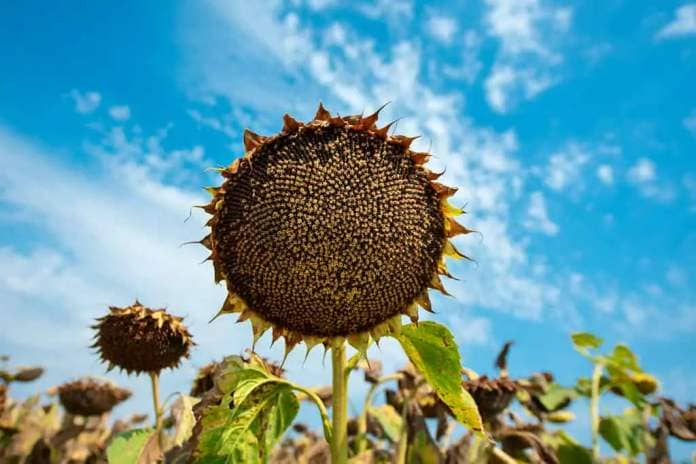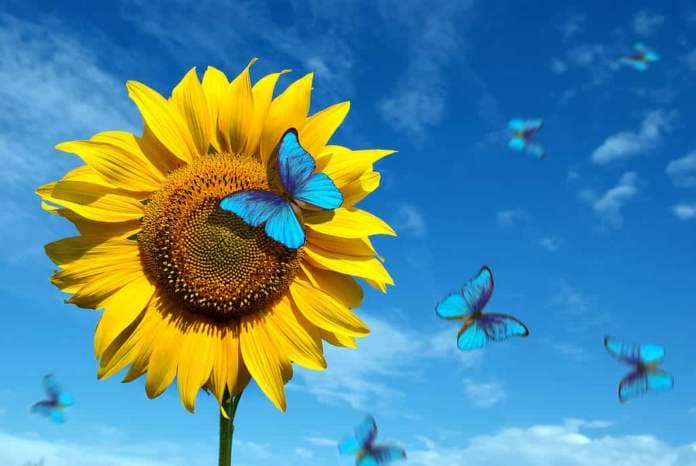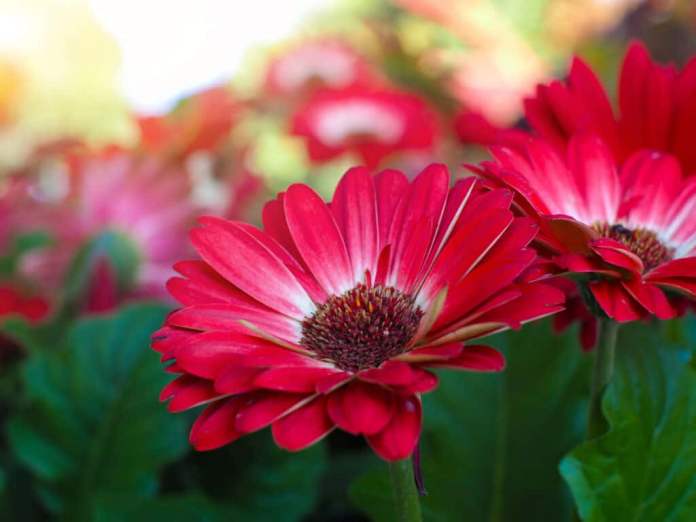Welcome to our guide for plant and cat owners! As pet owners, we all know how important it is to keep our furry friends safe and healthy. And as lovers of plants, we want to create a beautiful environment in our homes that also happens to be safe for our pets. In this article, we will focus on the question: are sunflowers toxic to cats? We understand the concern that comes with having these bright and cheerful flowers around your home while also ensuring your feline friend stays out of harm’s way. So let’s dive into some facts about sunflowers and their potential effects on cats so you can make an informed decision when it comes to incorporating them into your living space.
What is a Sunflower?

©Palukhin Andrii/Shutterstock.com
Sunflowers are a type of flowering plant that belongs to the family Asteraceae and the genus Helianthus. They typically grow tall, with some varieties reaching up to 12 feet in height. The stem is thick and sturdy, providing support for the large flower head at the top of the plant. Sunflower leaves are broad and rough in texture, ranging from green to gray-green in color.
The most distinctive feature of sunflowers is their large flower heads, which can measure up to 12 inches (30 centimeters) in diameter. The flower head consists of hundreds of individual flowers arranged in a spiral pattern around a central disk or receptacle. Each tiny flower has five petals that are bright yellow or golden in color.
In addition to their striking appearance, sunflowers have many practical uses as well. Their seeds can be harvested for use as food or feed, while their oil is commonly used for cooking and other purposes. Sunflower plants also help improve soil quality by drawing nutrients from deep underground and depositing them on the surface when they die back at the end of each growing season.
Overall, sunflowers are beautiful and versatile plants that can provide both aesthetic pleasure and practical benefits for gardeners and farmers alike. However, if you own cats, it’s important to know whether they pose any risks before planting them near your home!
Are Sunflowers Toxic to Cats?

©Brita Seifert/Shutterstock.com
As a cat owner, you may be concerned about the safety of your feline friend around certain plants. However, when it comes to sunflowers, rest assured that they pose no harm to your cat. In fact, all parts of the sunflower plant are safe for cats to be around and consume.
This includes not only the petals and flowers but also sunflower oil – a common ingredient in many foods and treats. So if you see your cat nibbling on some sunflower seeds or leaves from a nearby plant, there’s no need to panic.
Furthermore, dogs and horses can also safely interact with this popular flowering plant without any adverse effects. This makes it an excellent choice for gardeners and animal lovers alike who want to enjoy the beauty of these bright yellow blooms without worrying about potential harm.
Overall, knowing which plants are safe (or unsafe) for your pets is crucial as a responsible pet owner. Luckily when it comes to sunflowers, there’s no need for concern – they’re perfectly harmless!
How to Grow Sunflowers

©Alina Demidenko/Shutterstock.com
Growing sunflowers can be a fun and rewarding experience. Firstly, you should choose the right location for planting your sunflowers. Sunflowers require plenty of sunlight and well-draining soil with a pH level between 6.0-7.5.
Next, decide on the variety of sunflower you want to grow, as there are many different types available such as dwarf varieties, giant varieties, or multi-stemmed varieties. You will also need to consider how much space you have for planting them.
Sunflowers are typically planted around mid-spring but check the seed packet instructions for specific timing recommendations based on your location.
When planting the seeds, ensure they are spaced out evenly and buried at a depth of about 1 inch in well-prepared soil that has been watered beforehand. Water daily until germination occurs, which usually takes around 7-14 days, depending on the temperature.
Once your sunflowers have started growing taller than a foot (30 cm), you may need to provide support by tying them to stakes or trellises so they don’t fall over in strong winds.
It’s important to note that some pests like aphids and birds may attack your plants – but don’t worry! There are natural methods like insecticidal soap spray or bird netting available to help protect them without using harmful chemicals.
Finally, enjoy watching your beautiful sunflowers grow tall with their bright yellow petals facing toward the sky!
How to Harvest Sunflower Seeds

©5,184 × 2,480 pixels, file size: 5.24 MB, MIME type: image/jpeg – License
Harvesting sunflower seeds can be a fun and rewarding activity for plant owners. To begin, you’ll need to wait until the flower heads have fully matured and begun to droop, indicating that they are ready for harvesting. This usually occurs in late summer or early fall, depending on your location.
Once you’ve identified the right time to harvest your sunflower seeds, use a pair of garden shears or sharp scissors to cut off the entire flower head from the stem. You can then place this head upside down in a paper bag or other container and allow it to dry out completely over several weeks.
As the flower head dries out, you may notice that some of the individual seeds will start to loosen and fall off on their own. However, many will still remain attached tightly to their seed shells.
To remove these remaining seeds from their shells, simply rub them gently between your fingers or use a small tool like tweezers or pliers. Be sure to discard any damaged or discolored seeds, as these may not be viable for planting.
Overall, harvesting sunflower seeds is an easy process that can yield delicious snacks. So grab your gardening tools and get ready for a bountiful harvest!
How to Keep Sunflowers Fresh in a Vase

©KRIACHKO OLEKSII/Shutterstock.com
Sunflowers are a popular choice for vase flowers due to their bright and cheerful appearance. And now that you know sunflowers are not toxic to cats, you can safely bring them indoors. However, not all sunflowers are created equal when it comes to being used as cut flowers. The best sunflowers for vase arrangements have multiple branching stems and flowers, which can create a fuller and more visually appealing arrangement.
Another factor to consider when selecting sunflowers for use in vases is the amount of pollen they produce. Sunflowers that do not produce pollen will make less mess on your table or other surfaces where the vase may be placed. This can be particularly important if you have pets or children who may come into contact with the flower arrangements.
In addition to choosing the right type of sunflower, there are also steps you can take to keep them fresh in a vase for longer periods of time. One key tip is to change the water daily, ensuring that it remains clean and free from bacteria that can cause premature wilting or decay.
It’s worth noting that certain types of sunflowers tend to last longer than others once they’ve been cut and placed in a vase. In general, yellow and orange standard varieties tend to be more resilient than those with dark petals or petal bases. By following these guidelines, you’ll be able to enjoy beautiful arrangements featuring vibrant sunflowers without having to worry about their impact on your feline friends!
Other Cat-Safe Plants

©fon.tepsoda/Shutterstock.com
We have answered the question of whether sunflowers are toxic to cats. But are there any other plants that you can add to your garden or summer bouquet? Yes indeed!
Orchids are a popular choice among plant and cat owners alike. These elegant flowers come in many different colors and varieties, making them a versatile addition to any indoor or outdoor space. They require minimal maintenance, making them ideal for busy pet owners who don’t have much time to tend to their plants.
Asters are another type of flower that is safe for cats. These vibrant blooms come in shades of pink, purple, blue, and white and can add a pop of color to any garden or vase arrangement. They also attract beneficial insects like bees and butterflies, which can help pollinate other plants in the area.
Roses may be known for their thorns, but they are actually safe for cats. These classic flowers symbolize love and affection and come in an array of colors, from reds to pinks to yellows. While some rose bushes can be high maintenance, there are many low-maintenance varieties available that even novice gardeners can grow with ease.
Freesia is another cat-safe flower that is prized for its sweet fragrance as well as its delicate appearance. Its long stems make it perfect for use in floral arrangements, while its bright colors – ranging from pink to purple – bring cheerfulness wherever it’s planted.
Gerbera Daisies are often used as cut flowers because they last so long without wilting or losing their vibrant coloration. Their large petals come in many different hues, including yellow, orange, red, and pink, adding brightness anywhere they’re placed!
Liatris, also known as blazing star or gayfeather, is a perennial plant native to North America. It typically grows in full sun and well-draining soil, producing tall spikes of purple flowers that bloom in late summer. Liatris is safe for cats and can add some vibrant color and texture to your indoor or outdoor garden without posing any harm to your feline friends.


